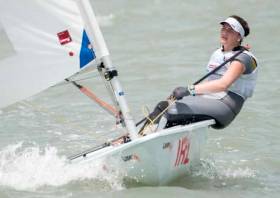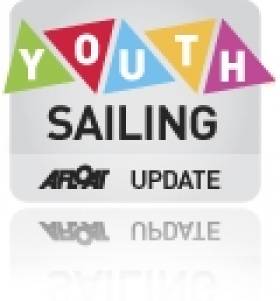Displaying items by tag: Laser Radial Youth Worlds
Staunton Leading Irish At Laser Radial Youth Worlds In Kiel
#Laser - A 12-strong team is representing Ireland at the Laser Radial Youth Worlds in Kiel, Germany which kicked off over the weekend.
Best of the bunch thus far is Nell Staunton of the National Yacht Club, fresh off her eight-place finish in last month’s Youth Sailing Worlds in the US, who stands in 18th place in the girl’s division on 23 points after two races.
Clare Gorman, also of the NYC and the only other Irish girl in Kiel, is in 67th after a black flag in her first race.
Leading the Irish contingent in the boys’ division is Hugo Kennedy (Royal St George), who holds 32nd place on the leaderboard on 22 points after two races.
Geoff Power (Waterford Harbour; 47th) and Tom Higgins (RStGYC; 49th) are the closest Irish boys, with Toby Hudson-Fowler (RStGYC) in 81st despite an impressive eight-point score in his second race; Dan McGaughey (Donaghadee SC) 132nd; Peter Fagan (Skerries SC) 138th; Henry Higgins (RStGYC) 148th; Jack Fahy (Lough Derg YC) 178th and Paddy Cunnane (Dingle SC) trailing at 207th with a disqualification in his first race.
Those struggling down the table have four more qualifiers to go before the big fleet races later this week.
Top Five Start for O'Dowd
Fresh from a top ten finish at the ISAF Youth Worlds, Dun Laoghaire sailor Matthew O'Dowd has started the Radial Youth World Championships in Largs with a second place finish.
The Laser fleet numbers some 210 boats, and has been split in three for the initial group stages. O'Dowd's second place in his 70-boat group puts him in fifth overall and sets a good tone for the rest of the regatta.
The Worlds, held in Largs, Scotland, lost its first day to light airs and had to wait until late in the afternoon yesterday to get racing in, whena steady, building northerly breeze trickled down the Clyde this afternoon allowing racing to commence.
The conditions were far from what the senior Radial fleet experienced at their world championship the previous week when gusts of 40kts swept through the fleet, but adequate enough to allow the 320 competitors to enjoy the first tactical race of the series.
Sailing on ‘home waters’, it was good to see 16-year-old GBR sailor Elliot Hanson demonstrating why he is one of the hot favourites here this week. Hanson finished sixth on these same Clyde waters last week at the Laser Radial World Championships. A former Topper UK national and world champion he benefited from the leading Hungarian’s windward mark-rounding error, and enjoyed a good race with Matthew O'Dowd (IRL), to win the one and only race of the day on the Boys’ course. Tadeusz Kubiak (POL) was also on top form winning Blue fleet, while Matthew Mollerus (USA) has made his intentions clear by winning the Red fleet.
On the girls’ course, set further to the north of Cumbrae, the situation was equally exciting with Julia Vallo Arjonilla (ESP) winning the first race in the Blue fleet and finishing third in Race 2 which puts her in a leading overall position. Pauline Barwinska (POL) snatched a win in Yellow fleet when Marketa Audyova (CZE) who crossed the line first, was deemed OCS.
Barwinska, fresh from competing at the Volvo Youth Sailing ISAF World Championship in Turkey is another race sharp sailor who showed she’s a real force to be reckoned with. She’s only been competing at international level for one year, so today’s result has given her a massive boost. The Japanese girls are also on top form with Manami Doi, and Momoko Tada taking wins in the second races (Yellow and Blue fleets).
Elliot Hanson (GBR): “We had quite tricky conditions to start with because the wind was up and down. I was second round the windward mark and then managed to chop and change with Matthew Odowd until the last run when I just managed to pull away. We started off with the most wind of the day at 12kts from the north generally. There were more pressure changes than shifts. The key today was to keep the speed up and reach the first windward mark in a decent position. But I think staying in the highest pressure was the key factor of the day. Some of the other British sailors did well today too and Cam Douglas – who was at the ISAF event, and John Currie who was second at the Youth Trials – are definitely two I’ll be watching out for this week.”
Full results from the event are HERE.

























































